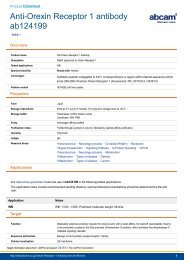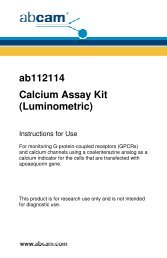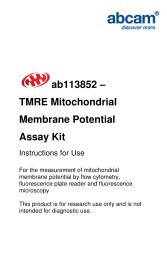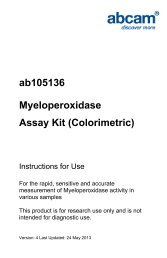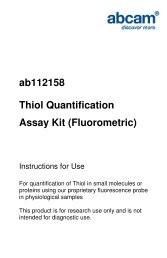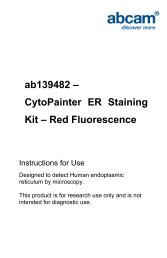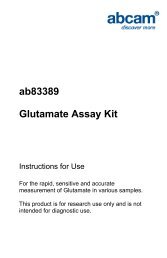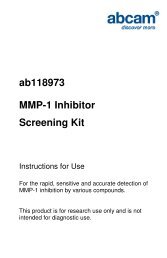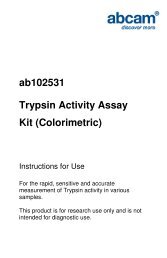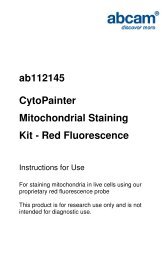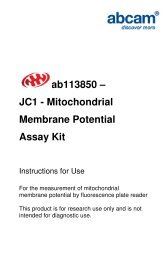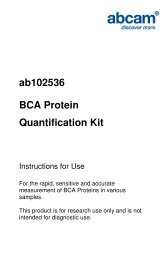ab126556 - BrdU Cell Proliferation ELISA Kit (colorimetric) - Abcam
ab126556 - BrdU Cell Proliferation ELISA Kit (colorimetric) - Abcam
ab126556 - BrdU Cell Proliferation ELISA Kit (colorimetric) - Abcam
Create successful ePaper yourself
Turn your PDF publications into a flip-book with our unique Google optimized e-Paper software.
<strong>ab126556</strong> - <strong>BrdU</strong> <strong>Cell</strong><strong>Proliferation</strong> <strong>ELISA</strong> <strong>Kit</strong>(<strong>colorimetric</strong>)Instructions for UseFor the quantitative measurement of <strong>BrdU</strong>incorporation into newly synthesized DNA ofactively proliferating cells.This product is for research use only and is notintended for diagnostic use.
Table of Contents1. Introduction 22. Principle of Assay 33. Assay Summary 44. <strong>Kit</strong> Contents 75. Storage and Handling 86. Additional Materials Required 87. Protocol 98. Typical Data 141
1. IntroductionA non-isotopic enzyme immunoassay for the quantification of DNAsynthesis and cell proliferation.Evaluation of cell cycle progression is essential for investigations inmany scientific fields. Measurement of [ 3 H] thymidine incorporationas cells enter S phase has long been the traditional method for thedetection of cell proliferation. Subsequent quantification of [ 3 H]thymidine is performed by scintillation counting or autoradiography.This technology is slow, labor intensive and has several limitationsincluding the handling and disposal of radioisotopes and thenecessity of expensive equipment.A well-established alternative to [ 3 H] thymidine uptake has beendemonstrated by numerous investigators. In these methodsbromodeoxyuridine (<strong>BrdU</strong>), a thymidine analog replaces [ 3 H]thymidine. <strong>BrdU</strong> is incorporated, into newly synthesized DNA strandsof actively proliferating cells. Following partial denaturation of doublestranded DNA, <strong>BrdU</strong> is detected immunochemically allowing theassessment of the population of cells, which are activelysynthesizing DNA.<strong>ab126556</strong> involves incorporation of <strong>BrdU</strong> into cells cultured inmicrotiter plates using the cell layer as the solid phase. The resultantassay is sensitive, rapid, easy to perform and applicable to highsample throughput. In addition to evaluation of cell proliferation,2
information such as cell number, morphology and analysis of cellularantigens can be obtained from a single culture.2. Principle of the Assay<strong>ab126556</strong> involves incorporation of <strong>BrdU</strong> into cells cultured inmicrotiter plates using the cell layer as the solid phase. During thefinal 2 to 24 hours of culture <strong>BrdU</strong> is added to wells of the microtiterplate. <strong>BrdU</strong> will be incorporated into the DNA of dividing cells. Toenable antibody binding to the incorporated <strong>BrdU</strong> cells must be fixed,permeabilized and the DNA denatured. This is all done in one stepby treatment with Fixing Solution. Detector anti-<strong>BrdU</strong> monoclonalantibody is pipetted into the wells and allowed to incubate for onehour, during which time it binds to any incorporated <strong>BrdU</strong>. Unboundantibody is washed away and horseradish peroxidase-conjugatedgoat anti-mouse antibody is added, which binds to the DetectorAntibody.The horseradish peroxidase catalyzes the conversion of thechromogenic substrate tetra-methylbenzidine (TMB) from a colorlesssolution to a blue solution (or yellow after the addition of stoppingreagent), the intensity of which is proportional to the amount ofincorporated <strong>BrdU</strong> in the cells. The colored reaction product isquantified using a spectrophotometer.3
3. Assay Summary<strong>Cell</strong> Plating:No test reagent/drug (skip next step) - Seed cells at 1-2 x 10 5cells/mL, 100 µl/well.With test reagent/drug (see next step) - Seed cells at 0.5-4 x 10 5cells/mL, 100 µl/well.Addition of Test Reagent(s)/Drugs: Add 100 µl/well, 2Xconcentration desired.Addition of <strong>BrdU</strong>: Dilute 500X stock <strong>BrdU</strong>, add 20 µl/well (be sure toinclude a No <strong>BrdU</strong> control).Incubate for 2 – 24 hours.Fix and Denature**Wash Step: Wash three times with 1X wash buffer and blot dry.Detector Antibody: Add 100 µl/well of prediluted Detector Antibody.4
Incubate for 1 hour at room temperature.Wash Step: Wash three times with 1X wash buffer and blot dry.Conjugation Addition: Add 100 µl/well HRP-conjugate.Incubate for 30 minutes at room temperature.Wash step and final water wash: Wash as above. Perform a finaldistilled water wash by flooding the entire plate with distilledwater. Pat dry on absorbent paper towels.Development: Add 100 µL/well TMB Peroxidase substrate.Incubate for 30 minutes at room temperature in the dark.Stop Solution: Add 100 µL of Stop Solution to every well.Read at 450/550 nm.5
**Adherent and Suspension <strong>Cell</strong>s (No-Spin Procedure wells):• Aspirate (or flick) the media from the cell wells.• Add 200 µl/well Fixing Solution.• Incubate 30 minutes at room temperature.• Aspirate the Fixing Solution and blot the plates dry.**Suspension <strong>Cell</strong>s (Spin Procedure):• Spin the plates for 5 minutes at 1000 rpm.• Aspirate media; add 200 µl/well Fixing Solution.• Incubate for 30 minutes at room temperature.• Aspirate the Fixing Solution and blot the plates dry.6
4. <strong>Kit</strong> Contents<strong>Kit</strong> contents listed for 200 tests:ItemQuantity<strong>BrdU</strong> Reagent: 500X solution of <strong>BrdU</strong> 15 µLFixing Solution2 x 20 mLPrediluted anti-<strong>BrdU</strong> detecting antibodyStop Solution20 mL25 mLPeroxidase Goat anti-mouse IgG (2000X) 15 µLConjugate Diluent: For dilution of Conjugate25 mLSubstrate: Ready to use tetramethylbenzidinesolution.25 µLPlate wash concentrate (50X): Concentratedsolution of buffered Tris and surfactant.90 mL7
5. Storage and HandlingUpon receipt, store entire kit at 4-8°C.Before first use:Remove the Fixative/Denaturing Solution and place at roomtemperature for at least 4 hours prior to use. Precipitates that mayoccur while cold should go back into solution.6. Additional Materials Required• 2-20 µl, 20-200 µl and 200-1000 µl precision pipettors withdisposable tips.• Wash bottle or multichannel dispenser for washing.• 2000 mL graduated cylinder.• PBS (137 mM NaCl, 2.7 mM KCl, 4.3 mM Na 2 HPO 4 -7H 2 O,1.4 mM KH 2 PO 4 ).• Deionized or distilled H 2 O• Spectrophotometer capable of measuring absorbance in 96-well plates using dual wavelength of 450-540 or 450-595 nmor a single read at 450 nm.8
• Tissue culture microtiter plate (96 well culture dish).• Sterile reagent troughs.• Micro syringe filter (0.2 µm).• Syringe7. ProtocolNotes: Do not expose reagents to excessive light. Do not mixreagents from different kits. The buffers and reagents used in this kitcontain anti-microbial and anti-fungal reagents. Care should betaken to prevent direct contact with these products.Recommended Controls:Two types of controls are recommended to insure validity of theexperiment.i. Blank: Add only tissue culture media (no cells).ii.Background: <strong>Cell</strong>s are present in the wells but do not addthe <strong>BrdU</strong> Reagent.1. <strong>Cell</strong> PlatingSeed cells using a sterile 96-well tissue culture plate, cells areplated at 2 x 10 5 cells/mL in 100 µl/well of appropriate cell9
culture media. Some of the wells on the plate should be setaside for several controls. These should include wells that do notreceive cells (media alone), and wells which contain cells but willnot receive the <strong>BrdU</strong> reagent (assay background).2. Addition of Test ReagentThe test reagent can be a cell proliferation enhancer oralternatively, can induce growth inhibition or arrest. The testreagent is diluted to twice the desired final concentration (2X) inthe cell media. 100 µl/well is added on top of the cell wells. Thetest reagent should be titered in the assay to determine optimumconcentration for inducing cell proliferation or growth arrest. Thelength of time for test reagent incubation should also bedetermined for your system (time course study). <strong>BrdU</strong> addition(see step 3 below) will occur 2-24 hours prior to the end of thetest.3. Addition of <strong>BrdU</strong><strong>BrdU</strong> will be incorporated into proliferating cells and should beadded at least 2 hours prior to the end of the test reagentincubation period. Better sensitivity and signal to noise ratios areobtained when longer <strong>BrdU</strong> labelling times are used. Dilute the500X concentrated stock 1:500 by adding 8 µl of <strong>BrdU</strong> stock to4 mL of cell media. Pipette 20 µl of the diluted <strong>BrdU</strong> label to theappropriate wells. Reminder: a series of wells should be setaside that do NOT receive the <strong>BrdU</strong> label (- <strong>BrdU</strong> control fordetermining assay background). Incubate the assay 2-24 hours.10
4. Fix and Denature Step and Storage of Fixed PlatesFor detection of the <strong>BrdU</strong> label by the anti-<strong>BrdU</strong> monoclonalantibody, it is necessary to fix the cells and denature the DNAusing a solution provided in this kit (Fixing Solution). There is noneed to spin the cells prior to addition of the fixing solution.However, if suspension cells are being used, better precision isobtained if the cell plates are spun in a centrifuge prior to thefix/denature step. Plates may be fixed (see steps 5-6) and storedat 4°C for assay at a later time. Place dried plates in a sealeddry plastic bag, zip-lock type bags or heat sealed plastic bagsare suitable for this purpose. Plates are stable for at least onemonth when properly stored.5. Adherent and Suspension <strong>Cell</strong>s (No-Spin Procedure)Aspirate the media from the cell wells (this can be donemechanically or plate can be inverted over appropriate reservoirand blotted on absorbent paper towels). Add 200 µl/well FixingSolution and incubate at room temperature for 30 minutes.Aspirate the Fixing Solution and blot the plate dry. Note: Fixedplates can be stored for up to 1 month at 4°C if stored in a heatsealed or zip-lock bag. If storing your plates for future use, makesure the plates are blotted well and are very dry (NO FixingSolution should be left in the wells).6. Suspension <strong>Cell</strong>s (Spin Fix/Denature Procedure)Spin the plates in the centrifuge (using appropriate centrifugemicrotiter plate holders) for 5 minutes at 1000 rpm. Aspirate the11
media and add 200 µl/well Fixing Solution. Incubate for 30minutes at room temperature. Aspirate the Fixing Solution andblot the plates dry. The assay can be run immediately or platesmay be stored for future use (see note above).7. Wash StepDilute the 50X Wash Buffer 1:50 by adding 40 mL to 1.96 L ofdistilled water. A microtiter plate washer may be used for allwash steps OR a squirt bottle for manual plate washing mayalso be used. In either case, the wells should be filled completelywith wash buffer. Wash the plate three times with 1X WashBuffer prior to adding Detector Antibody. Aspirate the washsolution after the final wash and blot dry on paper towels.8. Addition of Detector AntibodyThe anti-<strong>BrdU</strong> monoclonal Detector Antibody is provided as aprediluted solution. Add 100 µl/well and incubate for 1 hour atroom temperature.9. Wash StepWash as in Step 7 above.10. Preparation and Addition of the Peroxidase Goat Anti-Mouse IgG ConjugateThe Peroxidase Goat Anti-Mouse IgG Conjugate is provided asa concentrated stock solution. Dilute the Conjugate 1:2000 byadding 6 µl to 12 mL of Conjugate Diluent provided. Once12
diluted, this solution should be filtered using a 0.22 µmsyringe filter. This lowers the assay background and improvesprecision. Pipette 100 µl/well and incubate for 30 minutes atroom temperature.11. Wash Step and Final Water WashWash as in Step 7 above. Perform a final water wash byflooding the entire plate with distilled water. Pat dry onabsorbent paper towels.12. Addition of SubstrateFor 200 tests (Two 96 well plates):Pipette 100 µL/well TMB Peroxidase substrate and incubate for30 minutes at room temperature in the dark. Positive wells willbe visible by a blue color, the intensity of which is proportional tothe amount of <strong>BrdU</strong> incorporation in the proliferating cells.13. Addition of Stop Solution and Reading of the PlateStop the reaction by pipetting 100 µL of Stop Solution providedto every well. The color of positive wells will change from blue tobright yellow. Read the plate using a spectrophotometricmicrotiter plate reader set at a dual wavelength of 450/550 nm(alternatively, 450/540 nm or 450/595 nm may be used or asingle read at 450 nm).13
9. Typical DataA sensitivity study was performed using the Jurkat (non-adherent)and RH7777 and MCF7 (adherent) cells. Various concentrations ofthe cells were plated and cultured for 24 hours. The cells wereincubated with <strong>BrdU</strong> Label for 24 hours and incorporated <strong>BrdU</strong> wasdetected with <strong>ab126556</strong>. There was a direct relationship between thesignal and number of proliferating cells at all cell concentrations(Figure 1). The sensitivity of this assay was determined to be 40cells/well using the mean signal of zero plus two standard deviations;that is, the smallest number of cells that may be distinguished fromzero with 95% confidence. Using a two-hour <strong>BrdU</strong> labeling, 100cells/well was also significantly higher than the blank control.14
Figure 1a. Detection of MCF7 cells per well with 24 hour pulse with<strong>BrdU</strong>. Y axis - left, OD 450-550 nm. Y axis-right, signal-to-noiseratio.15
Figure 1b. Detection of Jurkat cells (non-adherent) per well with 24hour pulse with <strong>BrdU</strong>. Y axis - left, OD 450-550 nm. Y axis-right,signal-to-noise ratio.16
Figure 1c. Detection of RH7777 (adherent) cells per well with 2 hourpulse with <strong>BrdU</strong>. Y axis - left, OD 450-550 nm. Y axis-right, signal -to-noise ratio.17
UK, EU and ROWEmail: technical@abcam.comTel: +44 (0)1223 696000www.abcam.comUS, Canada and Latin AmericaEmail: us.technical@abcam.comTel: 888-77-ABCAM (22226)www.abcam.comChina and Asia PacificEmail: hk.technical@abcam.comTel: 108008523689 ( 中 國 聯 通 )www.abcam.cnJapanEmail: technical@abcam.co.jpTel: +81-(0)3-6231-0940www.abcam.co.jp19Copyright © 2012 <strong>Abcam</strong>, All Rights Reserved. The <strong>Abcam</strong> logo is a registered trademark.All information / detail is correct at time of going to print.



